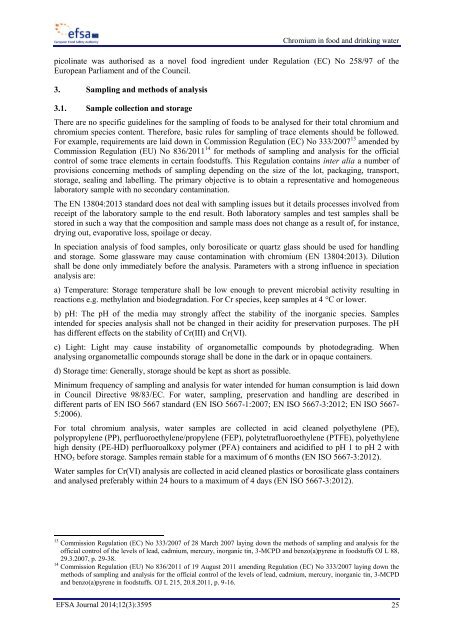efsa-opinion-chromium-food-drinking-water
efsa-opinion-chromium-food-drinking-water
efsa-opinion-chromium-food-drinking-water
Create successful ePaper yourself
Turn your PDF publications into a flip-book with our unique Google optimized e-Paper software.
Chromium in <strong>food</strong> and <strong>drinking</strong> <strong>water</strong><br />
picolinate was authorised as a novel <strong>food</strong> ingredient under Regulation (EC) No 258/97 of the<br />
European Parliament and of the Council.<br />
3. Sampling and methods of analysis<br />
3.1. Sample collection and storage<br />
There are no specific guidelines for the sampling of <strong>food</strong>s to be analysed for their total <strong>chromium</strong> and<br />
<strong>chromium</strong> species content. Therefore, basic rules for sampling of trace elements should be followed.<br />
For example, requirements are laid down in Commission Regulation (EC) No 333/2007 13 amended by<br />
Commission Regulation (EU) No 836/2011 14 for methods of sampling and analysis for the official<br />
control of some trace elements in certain <strong>food</strong>stuffs. This Regulation contains inter alia a number of<br />
provisions concerning methods of sampling depending on the size of the lot, packaging, transport,<br />
storage, sealing and labelling. The primary objective is to obtain a representative and homogeneous<br />
laboratory sample with no secondary contamination.<br />
The EN 13804:2013 standard does not deal with sampling issues but it details processes involved from<br />
receipt of the laboratory sample to the end result. Both laboratory samples and test samples shall be<br />
stored in such a way that the composition and sample mass does not change as a result of, for instance,<br />
drying out, evaporative loss, spoilage or decay.<br />
In speciation analysis of <strong>food</strong> samples, only borosilicate or quartz glass should be used for handling<br />
and storage. Some glassware may cause contamination with <strong>chromium</strong> (EN 13804:2013). Dilution<br />
shall be done only immediately before the analysis. Parameters with a strong influence in speciation<br />
analysis are:<br />
a) Temperature: Storage temperature shall be low enough to prevent microbial activity resulting in<br />
reactions e.g. methylation and biodegradation. For Cr species, keep samples at 4 °C or lower.<br />
b) pH: The pH of the media may strongly affect the stability of the inorganic species. Samples<br />
intended for species analysis shall not be changed in their acidity for preservation purposes. The pH<br />
has different effects on the stability of Cr(III) and Cr(VI).<br />
c) Light: Light may cause instability of organometallic compounds by photodegrading. When<br />
analysing organometallic compounds storage shall be done in the dark or in opaque containers.<br />
d) Storage time: Generally, storage should be kept as short as possible.<br />
Minimum frequency of sampling and analysis for <strong>water</strong> intended for human consumption is laid down<br />
in Council Directive 98/83/EC. For <strong>water</strong>, sampling, preservation and handling are described in<br />
different parts of EN ISO 5667 standard (EN ISO 5667-1:2007; EN ISO 5667-3:2012; EN ISO 5667-<br />
5:2006).<br />
For total <strong>chromium</strong> analysis, <strong>water</strong> samples are collected in acid cleaned polyethylene (PE),<br />
polypropylene (PP), perfluoroethylene/propylene (FEP), polytetrafluoroethylene (PTFE), polyethylene<br />
high density (PE-HD) perfluoroalkoxy polymer (PFA) containers and acidified to pH 1 to pH 2 with<br />
HNO 3 before storage. Samples remain stable for a maximum of 6 months (EN ISO 5667-3:2012).<br />
Water samples for Cr(VI) analysis are collected in acid cleaned plastics or borosilicate glass containers<br />
and analysed preferably within 24 hours to a maximum of 4 days (EN ISO 5667-3:2012).<br />
13<br />
Commission Regulation (EC) No 333/2007 of 28 March 2007 laying down the methods of sampling and analysis for the<br />
official control of the levels of lead, cadmium, mercury, inorganic tin, 3-MCPD and benzo(a)pyrene in <strong>food</strong>stuffs OJ L 88,<br />
29.3.2007, p. 29-38.<br />
14 Commission Regulation (EU) No 836/2011 of 19 August 2011 amending Regulation (EC) No 333/2007 laying down the<br />
methods of sampling and analysis for the official control of the levels of lead, cadmium, mercury, inorganic tin, 3-MCPD<br />
and benzo(a)pyrene in <strong>food</strong>stuffs. OJ L 215, 20.8.2011, p. 9-16.<br />
EFSA Journal 2014;12(3):3595 25



